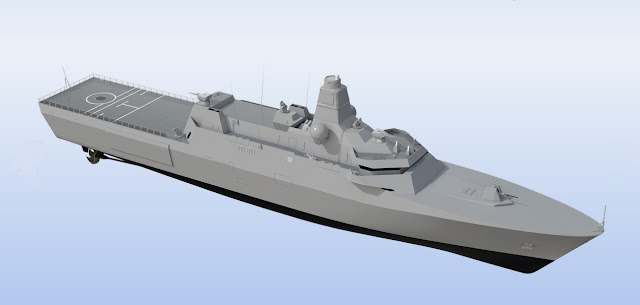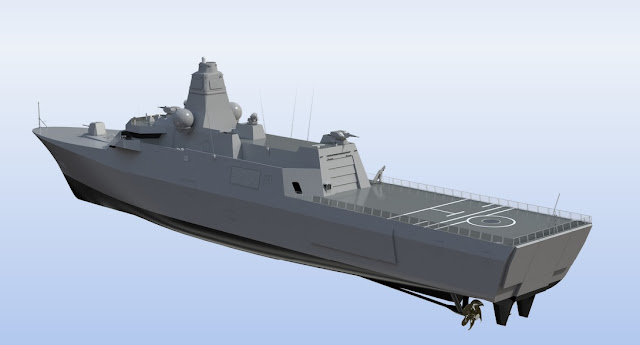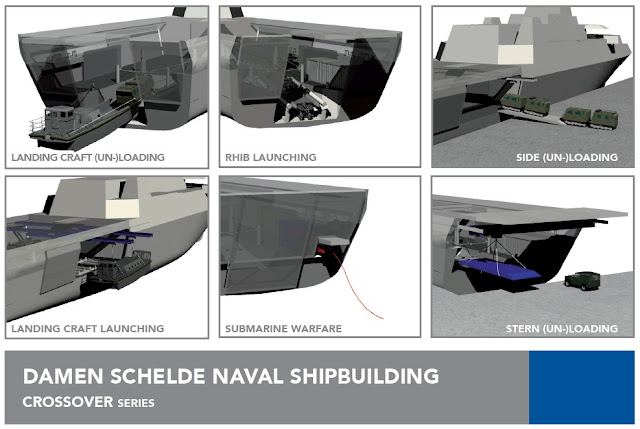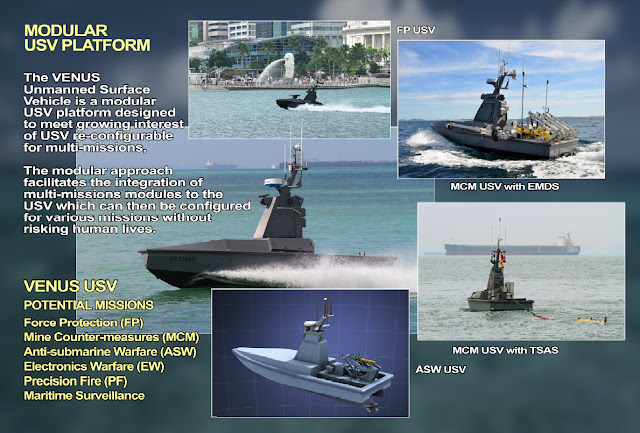 |
| JS Kumano ( FFM-2 ) launched 19th Nov 2020. Photo : JMSDF |
These frigates are meant to be compact, stealthy, highly automated to reduce crew requirements and are meant to be scalable for the possibility of export. Their design is a departure from the large destroyers that the JMSDF used to favour and reflects the changing regional security threats and demographic challenges that Japan is facing. A total of 22 frigates have been planned.
Destroyer Exclusivity No More
The Japanese archipelago is made up of 6852 islands and stretches for more than 3000km from the Sea of Okhotsk to the Philippine Sea. It has a coastline that is 29751km long and an exclusive economic zone of 4470000km2. Due to the vastness of the maritime territory it has to cover, the JMSDF has always required ships with very long range and high endurance. Destroyers have therefore formed the backbone of the JMSDF surface fleet for many decades. Its major combatants are always classified as a destroyer of sorts, helicopter-carrying destroyer ( DDH ), guided missile destroyer ( DDG ), general purpose destroyer ( DD ) and destroyer escort ( DE ). In fact, the JMSDF never had a frigate in its fleet apart from the 18 Kusu-class patrol frigates ( ex-US WWII Tacoma-class ) which it briefly commissioned between 1953 and 1972.
So it might seem like a surprise when after a lapse of almost five decades the JMSDF announced that its next generation warship would be a frigate. However, given the current maritime security situation with the militarization of the South China Sea, a nuclear-armed North Korea and multiple territorial disputes with neighbours including China, Taiwan, South Korea and Russia, it is clear that the JMSDF needs to build up its fleet to meet these challenges, and to do so rapidly and in an affordable manner. By virtue of its smaller size and less sophisticated weapon and sensor systems, a frigate is a lot cheaper to procure and maintain than a destroyer. Frigates also have a smaller complement, an important factor to consider given Japan's declining population and a younger generation unwilling to join the ranks of the JMSDF.
30FFM
The concept of a high speed multi-mission frigate that is capable of anti-submarine and mine warfare for the JMSDF was first raised in 2005 when the Maritime Staff Office engaged the Japan Association of Defense Industry on a feasibility study based on a vessel similar to the Littoral Combat Ship ( LCS ) of the US Navy. Then the emphasis was on speed and cost. However, the Japanese would soon discover that the cost of building such a ship was prohibitive, even when the specifications were brought down, and the idea was shelved.
It wasn't until late 2013 that saw the frigate being mentioned again, this time in the Defense Guidelines and the H26 Mid Term Defence Plans where the Ministry of Defense wanted to increase the number of escort ships from 47 to 54. The following year, the Japanese government under then Prime minister Abe Shinzo would also end the total ban on arms export and the frigate seemed viable again, perhaps with the help from a potential export market and lowered costs due to maturing technologies. By 2015, Mitsubishi Heavy Industries ( MHI ) had unveiled its proposal, the 30FF, which it had developed using its own funds.
 |
| MHI's 30FFM Conceptual Image, annotated |
The frigate was originally referred to as the 30FFM as it was promulgated in the defense budget of 2018, the 30th year of the Heisei era. FF is the hull classification for frigate and the M indicates its multi-mission capability but could also refer to the mine laying and mine hunting capabilities of this unique warship. Mine warfare is a highly specialised part of naval warfare and it is usually undertaken by specialised vessels like mine layers, mine sweepers and mine hunters. The conventional duty of a general purpose frigate is to escort other high value vessels like fleet replenishment ships and amphibious landing platforms and to conduct anti-submarine and anti-surface warfare but rarely ever to mine hunt or lay mines. In the FFM the JMSDF intends to create a work horse that is capable of a little of everything, including dealing with mines.
The 30FFM frigates are also frequently referred to as the 3900ton-class escort vessel ( 3900トン型護衛艦 ) as the design called for a ship with a standard displacement of 3900 tons. They are meant to expand the fleet and at the same time replace some of the older destroyers of the Asagiri-class ( 8 in active service ) and the Abukuma-class destroyer escort ( 6 in active service ).
Each of these frigates will cost 50 billion yen or about US$460 million.
 |
| FFM-2 JS Kumano being fitted out at Mitsui's Tamano yard 9th mar 2021. Photo : @DE224_cookie |
30FFM Specifications
Standard Displacement : 3900 tons
Full Load Displacement : 5500 tons
Length : 133m
Beam : 16.3m
Propulsion : CODAG
1 x Rolls Royce MT-30 Gas Turbine
2 x MAN 12V28/33D STC Diesel Engine
2 x variable-pitch propellers
Maximum Speed : Over 30 knots
Power : 70000hp
Complement : 90
Armament :
1 x BAE Systems 62 calibre 5 inch ( 127mm ) Mk 45 Mod 4 gun system
2 x Japan Steel Works RWS with 12.7mm machine gun
1 x Raytheon SeaRAM ship defense system
2 x quadruple canisters for a total of 8 MHI Type 17 anti-ship missiles ( SSM-2 )
2 x HOS-303 triple launchers for 324mm torpedoes
1 x MHI 16-cell Mk 41 VLS ( fitted for but not with )
Mine Warfare :
Simplified Mine Laying Equipment
1 x Unmanned Surface Vehicle ( USV ) with Expendable Mine Disposal System ( EMD )
1 x Unmanned Underwater Vehicle ( UUV ) MHI OZZ-5
C4I : OYQ-1 Combat Management System ( Link 22 compatible )
Sensors : Mitsubishi Electric OPY-2 X-Band multi-function AESA radar
Mitsubishi Electric OAX-3 Electro-optical / Infra-red sensor system
NEC OQQ-25 ship mounted sonar system comprising VDS + TASS
Hitachi OQQ-11 mine-detecting sonar
Electronic Warfare : NOLQ-3E electronic warfare system
4 x Mk 137 Decoy launchers
Hangar for 1 x SH-60K Helicopter
Updated : FFM-1 and FFM-2 ship crests here. Launch of FFM-3 here
 |
| JS Mogami being launched on 3rd Mar 2021 |
 |
| Sporting clean lines and flush surfaces. The stealthy JS Kumano shortly after launch. Photo : Hunini via Wikicommons. |
 |
| Profile view of the sleek and long JS Kumano shortly after being launched on 19th Nov 2020. Photo : Hunini via Wikicommons |
 |
| JS Kumano mid-ship starboard view with hatches possibly for torpedo launcher. Photo : Hunini via Wikicommons |
 |
| JS Kumano superstructure. Photo : Hunini via Wikicommons |
 |
| JS Kumano stern and hangar. Photo : Hunini via Wikicommons |
Unique Features
The Mogami-class frigate is radically different from what we would normally expect of a typical JMSDF surface combatant, big powerful ships with towering superstructures and masts full of radar and electronic warfare antenna, with an equally huge complement.
It is instead relatively smaller, stealthier, highly automated, not as well armed but still very capable, has an advanced combat management system and sensor suite and is intended to be multi-mission capable, including mine warfare.
 |
| The flat panels of the OPY-2 AESA multi-function radar on the tetrahedral mast proper of JS Kumano shortly after being launched. Photo : Hunini via Wikicommons |
Its design has incorporated the latest in stealth technology to drastically reduce the radar cross-section ( RCS ) of the ship. The sides of the frigate are smooth and flush and ship structures are angled to deflect radar waves. The most prominent feature is the single integrated mast combining the ship's radar with its electronic warfare system. The four flat panels of the multi-function OPY-2 radar are mounted on the sides of tetrahedral mast proper, with a tube-like NORA-50 composite communications antennae atop, completely clutter-free. MHI had also indicated that it applied some of the stealth technology from its X-2 experimental fighter on the frigates, presumably radar-absorbent coatings or paint. Simply put, the Mogami-class frigate is probably the stealthiest ship in the JMSDF inventory to date.
 |
| FFM-2 JS Kumano's integrated mast being fitted at Mitsui's Tamano yard 16th Feb 2021. Photo : mineo@youmaydream5 |
 |
| JS Kumano at Mitsui E&S Tamano yard 16th Feb 2021. Photo : mineo@youmaydream5 |
A high degree of automation allows the Mogami-class frigate to be operated by a crew of just 90 personnel, a drastic reduction from its predecessor the Asagiri-class destroyer which has a complement of 220. This is an extremely important adaptation as the JSDF as a whole had repeated failed to achieve its recruitment targets since 2014, with the JMSDF fairing the worse among the three services. Declining birth rates and a new generation of youths who cannot live without their always connected smart phones would pose insurmountable challenges. Possibly to reduce the impact of ship deployments on the personal lives of the crew, JMSDF plans to rotate four teams of crew for every three frigates.
The frigate also has an advanced integrated combat information centre ( CIC ) with a unique circular arrangement and open-bridge concept. It features 18 multi-function displays and 2 tactical tables and overhead screens that can project 360 degree augmented reality views of the ship with the assistance of sensor fusion technology. This will help to increase the situation awareness level of the CIC team.
Although well equipped for anti-surface warfare ( ASuW ) with the new Type-17 AShM and for anti-submarine warfare ( ASW ) with its combination of variable depth sonar, towed array sonar, torpedoes and ASW helicopter, the most unique capability of this frigate is its ability to conduct mine warfare.
The frigate has the ability to lay sea mines. It can also deploy and retrieve sonar equipped unmanned surface and underwater drones such as the OZZ-5 UUV to hunt and neutralise sea mines from a docking station at its stern. Its USV can also launch the expendable mine disposal system ( EMD ) which are controlled via optical fiber cable for mine hunting and destruction. This video shows how the EMD works. You can also watch it below.
 |
| Trainer EMD with dummy warhead in classic golden-yellow ( 山吹色 yamabuki-iro ) colour displayed onboard MSO-304 JS Awaji. Live ordnance would be painted black. Image : Wikipedia |
This mine warfare capability is mostly unheard of in frigates of any navy but it comes at a crucial time when the JMSDF is scaling down its mine countermeasures fleet. So the frigates can pick up the slack left by a dwindling MCM fleet to ensure that the waterways are mine free especially during amphibious operations in the defense of Japan's outer island chains.
 |
| Stern of JS Mogami seen just before launch. The larger opening leads to the USV / UUV docking station. The smaller opening is for VDS / TASS deployment. Photo @T_AH19 via twitter |
Currently, the frigate's weakness is in its air defense capabilities has it can only rely on the extremely short range SeaRAM close-in weapon system for self-protection against aerial threats. This may change once the 16-cell Mk 41 vertical launch system ( VLS ) is installed. The versatile VLS can pack the longer range RIM-162 ESSM four to a cell or it could accommodate the navalised version of the Type 3 medium-range surface-to-air missile. This will enable it to provide area air defense in an escort mission.
In addition, the Type 7 vertical launch anti-submarine rocket can also be launched from the VLS, boosting the frigate's kill capabilities against submarines. The VL ASROC is basically torpedo with a rocket delivery system that has a reach of 30km.
 |
| Celebrating the launch of FFM-2 Image : @gintokii via twitter |
Work Horse
With such a multitude of capabilities, the Mogami-class frigates are expected to be involved in the defense of Japan's home waters against surface and underwater threats. They augment the mine laying and mine hunting capabilities of JMSDF's organic mine-countermeasures fleet. They will also be deployed in anti-piracy operations overseas so that larger vessels like destroyers can be left to deal with bigger threats nearer to home, such as the Chinese, Russian and North Korean navies.
They mirror similar developments in other navies worldwide to have multi-mission capabilities built into a single hull and are frequently compared with the Littoral Combat Ship of the USN. The Republic of Singapore Navy's yet to be revealed Multi-Role Combat Vessel will probably share many similarities with the Mogami-class frigate, especially in mine warfare capabilities and emphasis on utilising remotely controlled vehicles.
There are also plans to export these vessels to lower the overall procurement costs. Indonesia is said to be interested in buying up to 8 frigates, with the first four being built in Japan and the remainder constructed in Indonesia. If this comes to fruition it will be Japan's first major arms export since WWII.
 |
| JS Mogami just after launch. Photo : JMSDF |
 |
| JS Mogami at MHI Nagasaki yard 4th Mar 2021. Photo : @xkVjYrGfhYAOspG via twitter |
 |
| JS Mogami at MHI Nagasaki yard 4th Mar 2021. Photo : @xkVjYrGfhYAOspG via twitter |
The first-in-class FFM-1 JS Mogami is named after the Mogami River* ( 最上川 ) in Yamagata Prefecture. It is the third vessel to bear that name, the first being the Imperial Japanese Navy's heavy cruiser IJN Mogami and the second was the destroyer escort JDS Mogami ( DE-212 ) of the JMSDF.
A mishap during the installation of the Rolls Royce MT-30 gas turbine delayed the launch of the lead ship, resulting in the second ship of the series, FFM-2 JS Kumano, being launched first. JS Kumano is named after the Kumano River ( 熊野川 ) in the mountainous Kii Peninsula of Kansai. Both are expected to be commissioned in March 2022.
The naming of the first two ships based on major Japanese rivers suggests that the other twenty might likely have river-based names such as Natori ( 名取 ), Tenryu ( 天竜 ), Kinu ( 鬼怒 ), Mikuma ( 三隈 ), Kiso ( 木曽 ), Tone ( 利根 ), Ishikari ( 石狩 ) and the likes. It follows the JMSDF tradition of naming its destroyers and major surface combatants after natural phenomena, meteorological phenomena, mountains, rivers and landmarks.
 |
| View of Mount Gassan from Mogami River. Ukiyo-e by Utagawa Hiroshige. Wikipedia |
* With a total length of 229km the scenic Mogami River is one of the longest and fastest flowing rivers in Japan. It was historically important as a conduit to transport goods from the inland areas of Dewanokuni (出羽国), modern day Yamagata and Akita, to the coastal areas for export.
The Mogami River was also featured in the hugely successful 1983 NHK serial television drama Oshin ( おしん ), in a snowy winter scene where the protagonist, a 7 year old girl from a poor peasant family, was tearfully separated from her parents and sent by raft down river to Sakata City to work as a babysitter for a timber merchant's family. Mogami River 0:14 - 0:20 in trailer for the 2012 movie adaptation.












